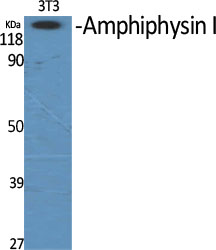Amphiphysin I Polyclonal Antibody
- Catalog No.:YT0214
- Applications:WB;ELISA
- Reactivity:Human;Mouse;Rat
- Target:
- Amphiphysin I
- Fields:
- >>Endocytosis;>>Fc gamma R-mediated phagocytosis
- Gene Name:
- AMPH
- Protein Name:
- Amphiphysin
- Human Gene Id:
- 273
- Human Swiss Prot No:
- P49418
- Mouse Gene Id:
- 218038
- Mouse Swiss Prot No:
- Q7TQF7
- Rat Gene Id:
- 60668
- Rat Swiss Prot No:
- O08838
- Immunogen:
- The antiserum was produced against synthesized peptide derived from human AMPH. AA range:131-180
- Specificity:
- Amphiphysin I Polyclonal Antibody detects endogenous levels of Amphiphysin I protein.
- Formulation:
- Liquid in PBS containing 50% glycerol, 0.5% BSA and 0.02% sodium azide.
- Source:
- Polyclonal, Rabbit,IgG
- Dilution:
- WB 1:500 - 1:2000. ELISA: 1:20000. Not yet tested in other applications.
- Purification:
- The antibody was affinity-purified from rabbit antiserum by affinity-chromatography using epitope-specific immunogen.
- Concentration:
- 1 mg/ml
- Storage Stability:
- -15°C to -25°C/1 year(Do not lower than -25°C)
- Other Name:
- AMPH;AMPH1;Amphiphysin
- Observed Band(KD):
- 76kD
- Background:
- This gene encodes a protein associated with the cytoplasmic surface of synaptic vesicles. A subset of patients with stiff-man syndrome who were also affected by breast cancer are positive for autoantibodies against this protein. Alternate splicing of this gene results in two transcript variants encoding different isoforms. Additional splice variants have been described, but their full length sequences have not been determined. A pseudogene of this gene is found on chromosome 11.[provided by RefSeq, Nov 2010],
- Function:
- disease:Antibodies against AMPH are detected in patients with stiff-man syndrome, a rare disease of the central nervous system characterized by progressive rigidity of the body musculature with superimposed painful spasms.,function:May participate in mechanisms of regulated exocytosis in synapses and certain endocrine cell types. May control the properties of the membrane associated cytoskeleton.,similarity:Contains 1 BAR domain.,similarity:Contains 1 SH3 domain.,subunit:Heterodimer with BIN1. Binds SH3GLB1 and AP2A2.,tissue specificity:Neurons, certain endocrine cell types and spermatocytes.,
- Subcellular Location:
- Cytoplasmic vesicle, secretory vesicle, synaptic vesicle membrane; Peripheral membrane protein; Cytoplasmic side. Cytoplasm, cytoskeleton.
- Expression:
- Neurons, certain endocrine cell types and spermatocytes.
- June 19-2018
- WESTERN IMMUNOBLOTTING PROTOCOL
- June 19-2018
- IMMUNOHISTOCHEMISTRY-PARAFFIN PROTOCOL
- June 19-2018
- IMMUNOFLUORESCENCE PROTOCOL
- September 08-2020
- FLOW-CYTOMEYRT-PROTOCOL
- May 20-2022
- Cell-Based ELISA│解您多样本WB检测之困扰
- July 13-2018
- CELL-BASED-ELISA-PROTOCOL-FOR-ACETYL-PROTEIN
- July 13-2018
- CELL-BASED-ELISA-PROTOCOL-FOR-PHOSPHO-PROTEIN
- July 13-2018
- Antibody-FAQs
- Products Images

- Western Blot analysis of various cells using Amphiphysin I Polyclonal Antibody
.jpg)
- Western Blot analysis of HeLa cells using Amphiphysin I Polyclonal Antibody

- Western blot analysis of the lysates from HUVECcells using AMPH antibody.



